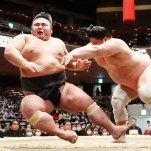

kozlodoev
Regular Members-
Content Count
9 -
Joined
-
Last visited
Community Reputation
0 NeutralAbout kozlodoev
-
Rank
Jonokuchi
- Birthday 15/05/1978
Profile Information
-
Location
Worcester, MA, USA
Affiliations
-
Favourite Rikishi
Kotooshu, Baruto
Recent Profile Visitors
678 profile views
-

Yokozuna Asashoryu Scandal - The Final Chapter
kozlodoev replied to madorosumaru's topic in Ozumo Discussions
Apparently, Asa's going to retire. http://www.breitbart.com/article.php?id=D9...;show_article=1 -
Frankly, I'd be surprised if he does get the nod. He went 12-3, but in a basho where two of the four ozeki left early (as a matter of fact, Bart got a no contest win against one of them, too).
-
This is not the correct answer at all. Statistical analysis suggests that 7-7 rikishi record a disproportionate amount of wins on senshuraku. For most rikishi who have already reached KK or MK before senshuraku, there is normally little or no incentive to go all out and risk injury in the final match. Unless a major promotion or award is on the line, one more victory or defeat will have a minimal impact on their career, but a needless major injury might. For the rikish who is 7-7, it is time to pump some adrenalin and go all out for it. This human dynamic throws some nasty goop in the sterile world of mathematical models. It is not yaocho. It is not ability. It is incentive. There may be an occasional instance of "good old boy" easing up, but this is not the classic yaocho. The data is correct; it's the interpretation that's flawed. Short of taking some brain scans and identifying the activities in the "I'm gonna play it safe" and "I got my money/favor, time to pay for it" sectors, data alone will not definitively answer the question of whether yaocho plays a part in such kachikoshi. (although rikishi are supposedly taught that not going all out leads to a greater chance of injury, so if you subscribe to that line of thought, the only reason a rikishi would risk injury by not going all out is if they had some compelling reason to lose...) The problem is the data goes on to suggest that the rikishi that have won on senshuraku under these circumstances also lose more often than they should when playing the same opponent next. I understand there are incentives for guys to make kachikoshi, but regretfully the data is consistent with a quid pro quo story. I strongly recommend reading the whole essay Freakonomics chapter. The analysis is less sterile than you might think :P
-
This is not the correct answer at all. Statistical analysis suggests that 7-7 rikishi record a disproportionate amount of wins on senshuraku. This guy references the original source: http://faroutliers.blogspot.com/2005/05/fr...cs-of-sumo.html
-
Should be around 135-138 kilos, I guess. Hmmm, he's officially listed at 143 or thereabout, I just thought maybe he gained some. I mean, it's pretty obvious that with his build he is not that stable when he takes charges from bigger men, which he compensates with extraordinary upper body strength and quickness of foot. I just think that there is an optimal point in his conditioning where he will be maximally stable without giving up any of that quickness, and he doesn't seem to have reached that yet. Ah well, we'll see during basho I guess.
-
I am curious about Kotooshu's weight...
-
Run the stream again and watch Asa's left feet. His left foot makes a very visible step to the left. I don't claim it's a henka, and it looks like the two rikishi made contact. But Asa most definitely did not make a step forward at all at the tachi-ai.
-
I think we got to read between the lines here. Osh would have been considered with a yusho here, and/or an upset of Asa. It looks like if he manages to come back and string 10+ wins next basho (giving him a total of at least 35 over the last 3 bashos), he will be considered for Ozeki. The trick is that there is no set requirements, so we'll have to wait and see

